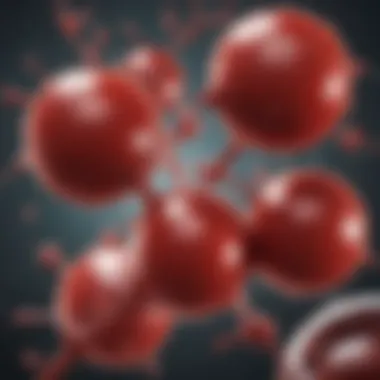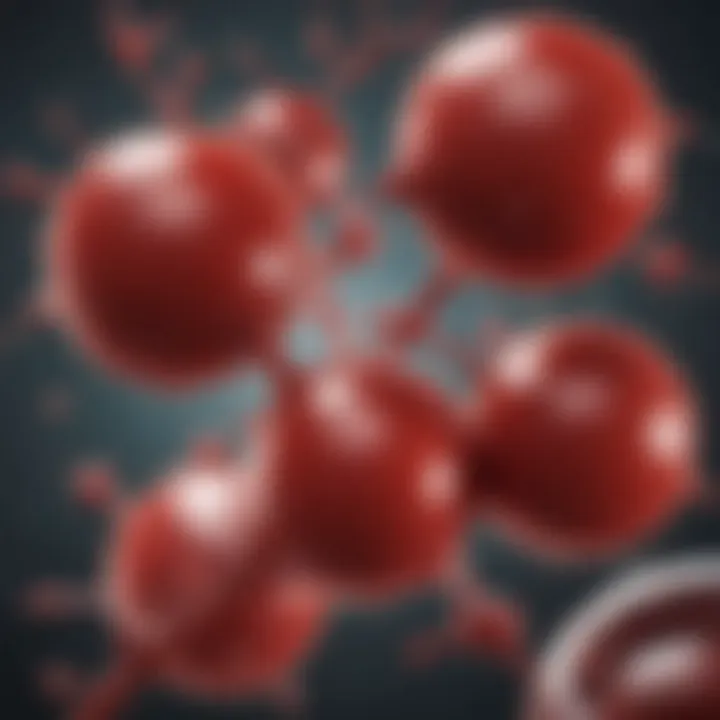Oxygenation: Its Vital Role Across Scientific Fields


Overview of Research Topic
Brief Background and Context
Oxygenation is a fundamental process that impacts numerous systems across various disciplines. It plays a vital role in biological organisms, especially in maintaining cellular functions and metabolic processes. The act of oxygen transfer occurs at both micro and macro levels, influencing everything from human health to ecosystem dynamics.
Historically, the understanding of oxygenation has evolved significantly. Ancient medical texts referenced air quality and its potential effects on health. In the modern era, researchers have extensively studied the biochemical pathways involving oxygen, revealing its critical importance in respiration and energy production within cells. Additionally, the concept extends its reach into atmospheric sciences, where oxygen cycles influence climate and ecological relationships.
Importance in Current Scientific Landscape
In contemporary research, oxygenation's significance is far-reaching. It holds importance in medicine, particularly in areas like hypoxia and its treatments. Advancements in technology have also enabled better monitoring and delivery of oxygen in clinical settings, improving patient outcomes.
The ecological aspects are equally crucial. Oxygenation affects aquatic ecosystems, influencing biodiversity and the health of various species. Additionally, atmospheric studies hinge on understanding oxygen's role in both supporting life and assisting in climate regulation.
Oxygenation is also increasingly relevant in discussions about environmental sustainability and resource management, emphasizing its importance across scientific fields. Thus, understanding oxygenation is essential for progress in health, ecology, and technology.
Methodology
Research Design and Approach
The exploration of oxygenation involves a multi-disciplinary approach. Researchers utilize various methodologies tailored to specific aspects of oxygenation. This includes reviewing existing literature, conducting laboratory experiments, and engaging in field studies to observe real-world oxygen delivery and consumption.
Case studies often highlight specific instances of oxygenation impact, whether in human subjects undergoing treatment or ecosystems facing changing conditions. This blend of qualitative and quantitative research allows for a comprehensive assessment of oxygenation's significance.
Data Collection Techniques
Data regarding oxygenation can be collected through multiple techniques:
- Laboratory experiments to measure oxygen levels under controlled conditions.
- Field studies which assess oxygenation in natural habitats or medical environments.
- Surveys and interviews with experts in particular fields to gather insights.
The amalgamation of this data provides a robust view of how oxygenation influences different sectors, hence allowing for a thorough understanding of its significance.
"Understanding oxygenation is crucial for both health and environmental sustainability."
Moreover, employing analytical tools and modeling techniques enhances the interpretation of the collected data. This integrated approach culminates in detailed insights that not only benefit academic research but also practical applications in various disciplines.
Defining Oxygenation
Oxygenation is a crucial process in various scientific fields, encompassing biology, chemistry, medicine, and environmental sciences. This concept involves the incorporation of oxygen into biological systems, affecting the life processes of living organisms. Understanding oxygenation is vital for comprehending how organisms sustain life, how chemical reactions take place, and how ecosystems function. It highlights the significance of oxygen in enhancing metabolic reactions and influencing overall health, as well as suggesting treatments for oxygen deficiency. Through deepening our grasp of this concept, we gain insight into the interconnectedness of life and the environment, which is particularly relevant in today's context of climate change and health crises.
Biological Perspective
From a biological standpoint, oxygenation is essential for cellular respiration. This process converts glucose and oxygen into energy, a fundamental requirement for all living beings. In multicellular organisms, oxygen molecules are delivered by the blood to tissues and organs, ensuring optimal cellular function. The role of hemoglobin in this process cannot be overstated; it binds oxygen in the lungs and transports it throughout the body. Furthermore, oxygenation supports various metabolic processes, influencing growth and development across species.
Chemical Basis
In terms of chemistry, oxygen is a reactive element that plays a pivotal role in many chemical reactions, particularly oxidation-reduction reactions. Oxygen's ability to accept electrons makes it an important partner in creating energy within cells. The process of oxygenation itself, which may involve the formation of different compounds, is central to understanding various biochemical pathways. This chemical perspective emphasizes how oxygen can alter the physical and chemical properties of substances, affecting everything from energy creation to environmental impact.
Historical Context
Oxygenation has a rich historical background, marked by significant discoveries that have shaped our understanding of life sciences. Since the late 18th century, scientists have worked to unravel the complexities of oxygen’s role in biology and chemistry. The discovery of oxygen's function in respiration by Joseph Priestley and Antoine Lavoisier laid the groundwork for modern biology. Over the years, our understanding has evolved, leading to advances in medical treatments as well as environmental science. Today, this historical context not only informs current research but also highlights the continuous quest for knowledge in understanding oxygen's vital role across disciplines.
Understanding oxygenation transcends simple definitions; it reflects the intricate network of life processes, chemical interactions, and historical developments that encompass this essential element.
The Physiology of Oxygen Transport
The physiology of oxygen transport is a central theme in understanding how oxygen functions in biological systems. It encompasses the mechanisms through which oxygen moves from the environment to the tissues of living organisms. This section delves into the biological components involved, detailing their roles and significance in sustaining life.
Oxygen in the Blood
Role of Hemoglobin
Hemoglobin is a protein found in red blood cells that plays a critical role in oxygen transport. Its primary function is to bind oxygen molecules in the lungs and release them in tissues where they are needed. Hemoglobin's ability to carry oxygen stems from its iron content, which allows it to bind oxygen molecules effectively. This characteristic makes it an essential element of oxygen transport, as it significantly increases the blood’s oxygen-carrying capacity compared to what could be dissolved in plasma alone.
A unique feature of hemoglobin is the cooperative binding nature of its structure, which enhances its efficiency in oxygen transport. When one oxygen molecule binds to hemoglobin, its shape changes in such a way that promotes further binding—this ensures that hemoglobin can pick up more oxygen in oxygen-rich environments and release it in low-oxygen areas. This efficiency is particularly beneficial under varied physiological conditions, such as during exercise.
However, hemoglobin also has its limitations. Factors such as pH and temperature can influence its affinity for oxygen. For example, higher carbon dioxide levels and lower pH (increased acidity) reduce hemoglobin's affinity for oxygen, leading to enhanced release in metabolically active tissues. Understanding these dynamics is crucial for analyzing how the body regulates oxygen delivery under different conditions.
Oxyhemoglobin Dissociation Curve
The oxyhemoglobin dissociation curve illustrates the relationship between hemoglobin saturation with oxygen and the partial pressure of oxygen in the blood. This curve is essential for understanding how efficiently oxygen is loaded into and unloaded from hemoglobin in response to changes in oxygen concentration.


A key aspect of the oxyhemoglobin dissociation curve is its sigmoidal shape, which reflects the cooperative binding properties of hemoglobin. At higher oxygen pressures, hemoglobin is nearly fully saturated, while at lower pressures, it releases oxygen more readily. This curve is a beneficial tool as it provides insights into how the body responds to varying oxygen levels, allowing us to model scenarios such as altitude acclimatization or respiratory pathologies.
One unique feature of the curve is its ability to shift due to physiological factors. For instance, a rightward shift indicates that hemoglobin is releasing oxygen more readily, often due to increased carbon dioxide levels or lower pH. Conversely, a leftward shift implies increased affinity for oxygen, which may occur at higher pH or during hypothermia. While these shifts can sustain oxygen delivery in demanding situations, they also highlight the delicate balance the body maintains in response to its environment.
Respiratory Mechanics
Gas Exchange Processes
Gas exchange processes are essential for the efficient transfer of oxygen from the atmosphere into the bloodstream and carbon dioxide in the opposite direction. These processes occur primarily in the alveoli of the lungs, where oxygen diffuses into the blood while carbon dioxide moves out. The interface between alveolar air and blood is where the critical exchange occurs due to the differences in partial pressures of the gases involved.
A key characteristic of gas exchange is its reliance on simple diffusion, which is influenced by factors such as surface area, concentration gradients, and membrane permeability. For instance, alveoli provide a large surface area, facilitating greater gas exchange efficiency. This design makes the respiratory system highly effective in managing the body's oxygen needs, especially during periods of high demand.
However, gas exchange can be adversely affected by conditions such as pulmonary diseases, which may reduce the surface area available or impair the diffusion process. Understanding these processes provides a foundation for improving respiratory health and developing treatment strategies in clinical settings.
Influence of Air Pressure
The influence of air pressure on oxygen transport is significant, particularly at different altitudes. Atmospheric pressure decreases with elevation, affecting how oxygen is available for breathing. At high altitudes, reduced air pressure lowers the partial pressure of oxygen, making it more challenging for the body to acquire sufficient oxygen.
A key characteristic of this influence is the body's adaptive mechanisms. Short-term adaptations include increased breathing rate and heart rate, while long-term adjustments may involve producing more red blood cells to enhance oxygen-carrying capacity. This adaptability is crucial for individuals in high-altitude environments, such as mountaineers.
Despite these adaptations, prolonged exposure to high altitudes can lead to altitude sickness, which further demonstrates the pressures' limitations on oxygen availability. Being aware of these challenges provides insight into the physiological aspects of oxygenation, linking environment and health directly.
Clinical Implications of Oxygenation
Understanding the clinical implications of oxygenation is essential for both medical professionals and researchers. This knowledge directly influences treatment protocols for various health conditions related to oxygen deficiency and informs ongoing research into therapeutic strategies aimed at improving oxygen delivery and utilization in the body. Examining the interplay between inadequate oxygen levels and health outcomes highlights the importance of oxygenation in clinical settings, where timely interventions can save lives and alleviate suffering.
Hypoxia and Health
Types of Hypoxia
Hypoxia refers to a deficiency in the amount of oxygen reaching tissues. It can manifest in several forms, which are critical for clinical understanding.
- Hypoxic Hypoxia: Occurs due to low partial pressure of oxygen in the environment, often encountered at high altitudes.
- Anemic Hypoxia: Caused by reduced hemoglobin levels or alteration in hemoglobin function, impacting oxygen transport.
- Ischemic Hypoxia: Relates to inadequate blood flow to tissues, rendering them deprived of oxygen and nutrients.
- Histotoxic Hypoxia: Occurs when cells are unable to utilize oxygen due to toxic substances, such as cyanide.
Each type offers unique insights into how oxygen deprivation can affect human health. Understanding these types helps in diagnosing the specific cause of hypoxia and tailoring appropriate interventions.
Cellular Responses
In response to hypoxia, cells initiate several adaptive mechanisms to survive the lack of oxygen. These responses include cellular metabolic shifts where cells decrease their energy requirements and utilize anaerobic processes.
- Increased Glycolysis: Cells may rely more on glycolysis for ATP production, resulting in lactic acid accumulation.
- Expression of Hypoxia-Inducible Factors (HIFs): These transcription factors help regulate genes that facilitate oxygen homeostasis, promoting angiogenesis and increasing erythropoiesis.
While adaptive responses are crucial for survival, they often lead to long-term cellular damage and can exacerbate underlying conditions. Recognizing these responses is vital in developing effective strategies to mitigate negative health impacts resulting from prolonged hypoxia.
Oxygen Therapy
Applications in Medicine
Oxygen therapy serves a fundamental role in treating various medical conditions. It is widely utilized in situations of respiratory distress, such as chronic obstructive pulmonary disease (COPD), pneumonia, and during surgeries.
- Enhances Tissue Oxygenation: By increasing the availability of oxygen to tissues.
- Reduces Work of Breathing: Helps patients with compromised lung function breathe easier.
Oxygen therapy not only improves patient outcomes but also enhances overall quality of life. Its versatility across different health scenarios makes it a vital tool in clinical practice.
Risks and Benefits
While the benefits of oxygen therapy are significant, it is important to consider the potential risks involved in its application.
- Risks: Extended exposure to high oxygen levels can lead to oxygen toxicity, which can damage lung tissues and lead to pulmonary edema.
- Benefits: Properly managed oxygen therapy can significantly increase survival rates in critically ill patients and reduce the severity of respiratory conditions.
A balanced approach to administering oxygen therapy, taking both risks and benefits into account, is crucial for achieving optimal patient outcomes.
The intricate balance between adequate oxygenation and potential toxic exposure underscores the importance of clinical guidance in oxygen therapy.
Understanding the clinical implications of oxygenation, including the intricacies of hypoxia and the role of oxygen therapy, equips healthcare professionals to take informed decisions that ultimately enhance patient care.
Oxygenation Across Ecosystems
Oxygenation plays a significant role in maintaining the balance of various ecosystems. Understanding this topic is essential for grasping how oxygen affects both terrestrial and aquatic environments. It helps in assessing the health of ecosystems, the survival of species, and the overall functioning of the planet. Oxygen is not just vital for human health; its presence and distribution have profound effects on biodiversity, nutrient cycling, and climate regulation.
Photosynthesis and Oxygen Production


Photosynthesis is the primary process through which oxygen is produced in our ecosystems. Plants, along with algae and some bacteria, convert sunlight, carbon dioxide, and water into glucose and oxygen. This reaction forms the foundation of the food chain, thereby sustaining life on Earth.
- The rate of oxygen production varies depending on the type of vegetation and environmental conditions.
- Forests and marine phytoplankton are among the largest contributors to oxygen in the atmosphere.
- Areas rich in vegetation typically show higher levels of oxygen and support greater biodiversity.
Aquatic Systems and Oxygen Levels
Aquatic systems face unique challenges regarding oxygen levels. Dissolved oxygen is crucial for the survival of aquatic organisms. The levels of oxygen can fluctuate widely due to several factors, including temperature, salinity, and the presence of organic matter.
Importance for Marine Life
Oxygen levels are critical for marine life. Fish, mollusks, and many other aquatic organisms depend on dissolved oxygen for respiration. When oxygen levels are adequate, aquatic ecosystems thrive; however, lower levels can lead to significant stress on marine species.
- Marine life exhibits different adaptations based on oxygen availability.
- Species such as the tardigrades can withstand low oxygen conditions, but most have specific tolerance levels affecting habitat distribution.
- A balance of oxygen is necessary for reproductive success and overall health of marine communities.
Eutrophication Effects
Eutrophication refers to the process where water bodies receive excess nutrients, leading to algal bloom. This significantly affects oxygen levels. As algae die and decompose, they consume large amounts of oxygen, often resulting in hypoxic conditions, which can devastate marine ecosystems.
- Eutrophication is often triggered by runoff from agriculture and urban areas.
- This process can lead to fish kills and loss of biodiversity, affecting both ecological and economic aspects of communities relying on marine resources.
- Understanding eutrophication effects is critical for developing strategies for ecosystem management and rehabilitation.
"Monitoring and managing oxygen levels is vital for maintaining the health of both aquatic and terrestrial ecosystems."
The Role of Oxygenation in Climate Science
Understanding the role of oxygenation in climate science is crucial. Oxygen levels and their fluctuations impact carbon cycling, ecosystem health, and even climatic shifts. Proper oxygenation influences various biogeochemical processes and contributes to homeostasis in different systems. When considering climate change, oxygen acts as both a substrate and a product in various natural processes.
Oxygen Levels in the Atmosphere
Historical Changes
The historical changes in atmospheric oxygen levels provides insight into the evolution of Earth’s climate. These changes have significant implications for life and ecosystems throughout geological time. During the Carboniferous period, oxygen levels peaked, promoting a vast array of plant and animal life.
With fossil fuel combustion and deforestation, current atmospheric levels are lower than past epochs.
This gradual decline of oxygen is a key characteristic in understanding anthropogenic impacts. It highlights an urgent environmental concern, making it a popular choice for researchers. The unique feature here is how historical trends in oxygen correlate with periods of climatic stability or upheaval. Recognizing these patterns helps advocate for responsible environmental practices today.
Current Trends
Current trends in oxygen levels show a worrying decline correlated with increased carbon dioxide emissions. Industries and urbanization contribute consistently to atmospheric changes, impacting natural oxygen replenishment processes.
The key characteristic of this trend is its speed. Scientists are observing rapid alterations in oxygen levels, which make it critical to monitor. These trends serve as a timely reminder of the consequences of neglecting environmental stewardship. While there are advanced technology and methodologies to track changes, the challenge remains to implement effective global solutions.
Impact on Global Warming
Oxygen plays a multifaceted role in global warming. An increase in greenhouse gas emissions contributes significantly to heat retention in our atmosphere. As oxygen levels fluctuate, they can affect processes such as photosynthesis, where reduced oxygen production leads to increased carbon dioxide levels.
Oxygenation levels influence global temperatures and can either exacerbate or mitigate climate change effects. Research shows that higher temperatures can lead to reduced oxygen levels in oceans, impacting marine ecosystems. Oxygen depletion not only poses direct threats to ocean life but can also amplify the effects of global warming. Therefore, understanding oxygenation is vital in formulating effective climate policies.
Advancements in Oxygenation Technology
The significance of advancements in oxygenation technology extends across various fields, significantly enhancing our understanding and management of oxygen levels in both medical applications and environmental contexts. As research progresses, new tools and methods emerge, leading to improved patient outcomes and insights into ecological health. The role of these technologies is crucial in addressing the complexities of oxygen management, providing opportunities for innovative solutions that cater to diverse needs.
Oxygen Sensors
Oxygen sensors play a pivotal role in monitoring oxygen levels in various environments. These devices measure the concentration of oxygen in gases or liquids, enabling real-time data analysis. In clinical settings, they are used to assess patient oxygenation and make timely decisions regarding treatment. The importance of oxygen sensors is underscored in critical care situations, where accurate monitoring can mean the difference between life and death. The precision and reliability of these sensors have improved remarkably, with advancements focusing on miniaturization and enhanced sensitivity.
Innovations in Medical Devices
Portable Oxygen Concentrators
Portable oxygen concentrators represent a significant leap in oxygen therapy technology. They allow patients to receive oxygen treatment outside of traditional healthcare settings. The key characteristic of these devices is their ability to filter and concentrate oxygen from ambient air, delivering a prescribed level of oxygen at different flow rates. This makes them a convenient choice for patients who require continuous oxygen support.
One unique feature of portable oxygen concentrators is their lightweight design, which enhances mobility and factor in quality of life.
Advantages of these devices include their adaptability, enabling use during travel or daily activities. However, considerations must be made regarding battery life and the need for frequent maintenance, which can pose challenges for some users.
Non-Invasive Monitoring Systems
Non-invasive monitoring systems have revolutionized how healthcare providers assess oxygenation status. These systems measure oxygen saturation levels without the need for blood draws or invasive procedures, making them a non-invasive and appealing option for patients.
A primary characteristic of non-invasive monitoring systems is their ease of use and quick data retrieval. These systems provide continuous monitoring, particularly beneficial in critical care, helping in prompt decision-making.


The unique feature of these systems includes the ability to transmit data wirelessly, making it possible for healthcare professionals to monitor patients remotely. The advantages are clear: improved patient comfort and reduced risk of infection. However, challenges exist, such as variability in readings and the need for calibration.
In summary, advancements in oxygenation technology, such as oxygen sensors and innovative medical devices, are essential for enhancing both individual health outcomes and environmental monitoring. The continuous evolution of these tools paves the way for more effective and accessible solutions.
Future Directions in Oxygenation Research
Research in oxygenation moves continually, adapting to new challenges and opportunities across various fields. This section delves into two primary avenues: alternative therapies and sustainable practices for oxygen production. Both areas of inquiry are essential for enhancing our overall understanding and approach to oxygenation.
Investigating Alternative Therapies
The investigation of alternative therapies for oxygenation has substantial significance mainly in medical and therapeutic contexts. With mounting evidence indicating the importance of oxygen levels in healing processes, exploring new methods could revolutionize patient care.
For instance, hyperbaric oxygen therapy (HBOT) is already gaining attention for its efficacy in treating conditions such as decompression sickness and chronic wounds. By providing an environment where oxygen can dissolve more effectively, HBOT promotes healing and reduces inflammation. Researchers are now looking into its potential in treating conditions like stroke and traumatic brain injury, suggesting that it may facilitate cellular recovery in ways previously unconsidered.
Expanding research into alternative therapies offers benefits beyond immediate medical outcomes. It encourages interdisciplinary collaboration, drawing insights from fields like biochemistry and engineering to refine these therapies further. The blending of insights drives innovation, vital for advancing current methodologies. However, careful evaluation of efficacy, safety, and accessibility is crucial as this field evolves.
Sustainable Practices for Oxygen Production
Sustainable practices for oxygen production reflect a holistic approach to addressing ecological concerns while simultaneously ensuring sufficient oxygen levels for all living organisms. This aligns with the broader objective of maintaining balance within ecosystems as global demand for oxygen increases.
Bioengineering Solutions
Bioengineering solutions utilize scientific principles to create systems that enhance oxygen production. This includes engineering plants or algae to optimize photosynthesis or improve efficiency in oxygen generation. Notably, genetically modified organisms can potentially yield higher oxygen outputs, addressing significant oxygen deficits in various environments.
A key characteristic of bioengineering is the ability to tailor organisms specifically for desired outcomes. This flexibility makes it a popular choice for enhancing oxygenation in agriculture and marine environments. These engineered organisms may also tolerate environmental stresses, ensuring more consistent oxygen output.
However, the adoption of bioengineering solutions is not without challenges. Potential risks include unintended ecological impacts and ethical concerns regarding genetic modification. Therefore, thorough research and monitoring are necessary to assess their long-term effects.
Preserving Natural Ecosystems
Preserving natural ecosystems is crucial for maintaining the planet's oxygen 공급. The role of forests and oceans as primary oxygen sources cannot be overstated. Deforestation and pollution threaten these critical systems, resulting in decreased biodiversity and emptying air quality.
One key advantage of maintaining natural ecosystems is their self-sustaining capability. Healthy forests and oceans naturally produce and recycle oxygen, contributing positively to climatic stability. Furthermore, these ecosystems provide additional benefits, such as carbon sequestration and habitat provision for myriad species.
While the efforts to preserve these systems are crucial, they often face obstacles like urban expansion and climate change. Resistance to change and resource constraints can limit effectiveness. Concerted global efforts and policies are required to adopt degradable practices that protect and enhance these vital ecosystems.
Effective oxygenation research is multidisciplinary, bridging various academic and applied fields, leading to innovative solutions for pressing environmental and health challenges.
Interdisciplinary Approaches to Oxygenation Studies
Interdisciplinary approaches are essential for understanding oxygenation in its full complexity. This multifaceted topic requires insights from various disciplines to address the challenges and questions that arise. Each field contributes unique perspectives and methodologies, enriching the overall research landscape on oxygenation. Collaboration fosters innovation, leading to more robust solutions in healthcare, environmental science, and beyond. Bringing together experts in biology, chemistry, physics, and earth sciences can yield greater understanding and practical applications.
Collaboration Between Fields
Biology and Chemistry
Biology and Chemistry interact profoundly when studying oxygenation. A critical aspect is how biochemical processes depend on oxygen. For example, cellular respiration involves oxygen as a key reactant in generating energy in living organisms. This fundamental relationship highlights the interdependence of biological systems and chemical reactions.
The key characteristic of this collaboration is its ability to explain living processes at a molecular level. This intertwining enhances our understanding of how oxygen affects health. It is beneficial for developing therapies targeting cellular dysfunction. However, adopting such an interdisciplinary approach requires careful consideration of different terminologies and fundamental principles.
Unique to this collaboration is the ability to translate complex chemical interactions into biological phenomena. One advantage is the potential for breakthroughs in medical interventions. Conversely, the integration can present challenges when aligning various research paradigms.
Physics and Earth Sciences
Physics and Earth Sciences also offer valuable insights into the culture of oxygenation studies. They explore how oxygen circulates within ecosystems and its role in thermal dynamics. The specifics of these sciences help explain gas behaviors under various environmental conditions, essential for understanding atmospheric oxygen availability.
A unique characteristic of this collaboration is the emphasis on spatial and temporal factors when observing oxygenation patterns. Earth sciences contribute to understanding oxygen levels in different habitats. This perspective is vital in discussions regarding global warming and climate change effects.
The advantages of merging physics with earth sciences include advancing knowledge about natural systems and atmospheric processes. However, challenges may arise when outcomes observed from these disciplines need proper contextualization in biological or chemical frameworks.
The End: The Vital Importance of Oxygenation
Oxygenation is a central theme that resonates across various disciplines. The significance of oxygenation cannot be overstated. It is essential for life on Earth, underpinning biological processes, ecological dynamics, and technological advancements. This article has illustrated how oxygenation is not just a biological necessity but also a multifaceted concept that spans different fields, including medicine, environmental science, and engineering. Understanding its importance can lead to better health outcomes, more effective environmental policies, and innovative technological developments.
Summary of Key Insights
Throughout this exploration, several key insights emerged:
- Biological Significance: Oxygen plays a crucial role in cellular respiration, allowing organisms to produce energy. The transport of oxygen within the bloodstream, primarily through hemoglobin, is fundamental to health and vitality.
- Clinical Relevance: Conditions like hypoxia highlight the critical consequences of oxygen deprivation. Effective oxygen therapy has shown substantial benefits for patients with respiratory diseases, making knowledge of oxygenation vital for healthcare professionals.
- Environmental Impact: Oxygenation affects ecosystems profoundly. Photosynthesis produces oxygen that supports aquatic life, and the balance of oxygen levels is vital for maintaining biodiversity.
- Technological Innovations: Advancements in oxygen sensing technologies and portable oxygen devices are revolutionizing medical care and environmental monitoring. These innovations continue to improve quality of life and enhance research capabilities.
Future Perspectives
Future research in oxygenation should focus on several promising areas:
- Alternative Therapies: Investigating how different approaches to increase oxygen delivery or utilization can benefit various health conditions may open new avenues in medical treatment.
- Sustainable Practices: As we face environmental challenges, developing bioengineering solutions for oxygen production and maintaining natural ecosystems will be crucial. Understanding the interdependency of oxygen levels and climate health should inform policies and practices.
- Interdisciplinary Collaboration: Enhanced cooperation between biology, chemistry, and environmental sciences will lead to a more comprehensive understanding of oxygenation's role in both ecological and human health. Cross-disciplinary studies can yield insights that single-discipline research may overlook.
Oxygenation remains a pivotal topic that warrants continued attention and study, driven by its implications for life, health, and the environment. As this article has articulated, a thorough understanding of oxygenation is not merely academic; it is imperative for sustainable living and fostering advancements in numerous sectors.



